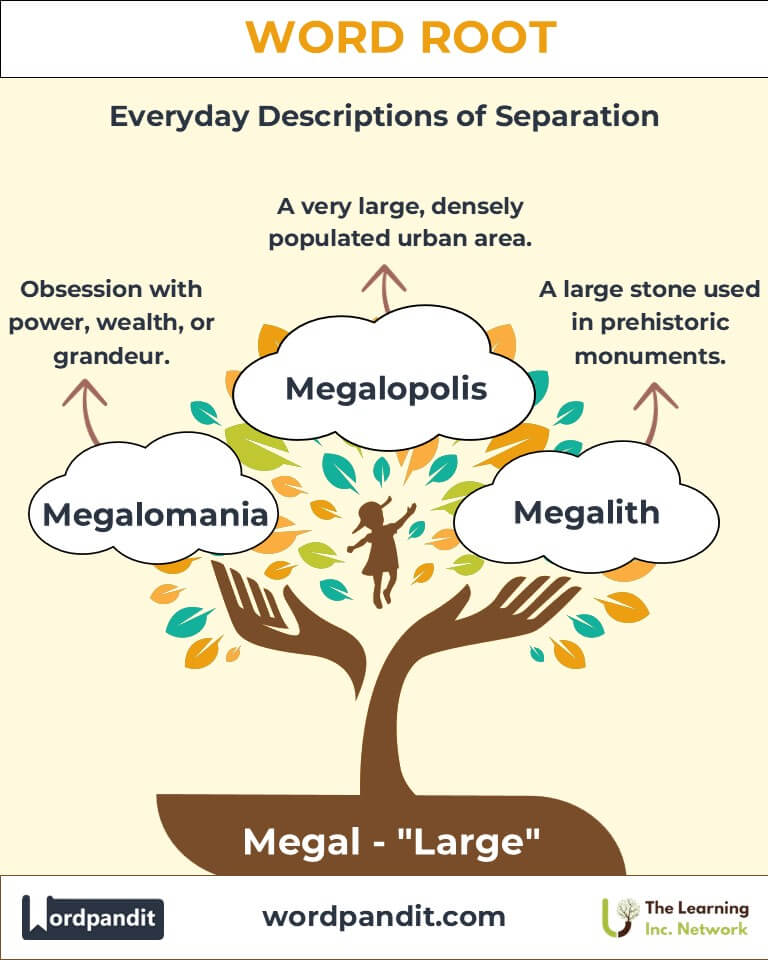Megal: The Root of Grandeur in Language and Thought
Byline: Dive into the expansive world of the word root "megal," derived from the Greek megas, meaning "large" or "great." From psychological phenomena to ancient architecture, "megal" shapes words that describe vastness and grandiosity.

Table of Contents
- Introduction: The Essence of "Megal"
- Etymology and Historical Journey
- Mnemonic: Unlocking the Power of "Megal"
- Common "Megal"-Related Terms
- "Megal" Through Time
- "Megal" in Specialized Fields
- Illustrative Story: "Megal" in Action
- Cultural Significance of the "Megal" Root
- The "Megal" Family Tree
- FAQs About the Megal Word Root
- Test Your Knowledge: Megal Word Root Quiz
- Conclusion: The Enduring Legacy of Kerat
Introduction: The Essence of "Megal"
The root "megal" brings to mind images of towering skyscrapers, grandiose ideas, and overwhelming ambitions. Pronounced MEG-uhl, this root originates from the Greek megas, meaning "large" or "great." It is foundational in words that capture the enormity of size, scale, or ego. From megaliths of ancient history to megalomania in psychology, this root helps us describe the grand and sometimes excessive.

Etymology and Historical Journey
The Greek root megas evolved into "megal," carrying its sense of vastness across time and languages. In ancient Greece, megas described physical size, such as in massive structures or grand achievements. When absorbed into Latin and later English, it gained abstract meanings, symbolizing both literal and figurative largeness. The word megalith (large stone) connects to ancient monuments, while megalomania emerged in the 19th century to describe an obsession with power or greatness.
Mnemonic: Unlocking the Power of "Megal"
To remember "megal," picture a giant statue standing on a sprawling plain, its size dwarfing everything around it. This imagery ties to the root’s essence of largeness.
Mnemonic: "Megal means massive—like a colossal stone or an inflated ego."
Common "Megal"-Related Terms
- Megalomania (meg-uh-loh-MAY-nee-uh):
- Definition: Obsession with power, wealth, or grandeur.
- Example: "His megalomania led him to build an empire, regardless of the cost to others."
- Megalith (MEG-uh-lith):
- Definition: A large stone used in prehistoric monuments.
- Example: "Stonehenge is one of the world’s most famous megalithic structures."
- Megabyte (MEG-uh-bite):
- Definition: A unit of computer data equal to one million bytes.
- Example: "This software requires at least 50 megabytes of free space."
- Megalopolis (meg-uh-LOP-uh-lis):
- Definition: A very large, densely populated urban area.
- Example: "The Northeast Corridor in the U.S. is considered a megalopolis."
- Megalodon (MEG-uh-luh-don):
- Definition: An extinct species of giant shark.
- Example: "The megalodon ruled the seas millions of years ago."
"Megal" Through Time
- Megalith:
Originating in prehistoric times, these large stones marked rituals or burials.
Cultural Shift: Once only associated with ancient sites, "megalith" now symbolizes anything monumental.
- Megalomania:
Coined in the 19th century to describe delusional grandeur.
Evolution: Expanded to cultural and political contexts, often linked to dictatorial ambitions.
"Megal" in Specialized Fields
- Psychology:
Megalomania is a clinical term for delusions of grandeur and is a symptom in some mental health disorders.
- Archaeology:
Megaliths provide insight into prehistoric societies and their cultural practices.
- Urban Studies:
Megalopolis describes massive urban sprawls with interconnected cities, influencing infrastructure planning.
Illustrative Story: "Megal" in Action
Archaeologist Dr. Sophia Marquez stood before the towering megaliths of a newly discovered ancient site. As she marveled at the scale, she imagined the megalomania of the leaders who had commissioned such grandiose structures. Meanwhile, her colleague speculated about the site’s resemblance to modern megalopolises, drawing parallels between past and present civilizations.
Cultural Significance of the "Megal" Root
"Megal" captures humanity’s fascination with bigness, whether in physical form, ambition, or influence. Megaliths like Stonehenge are cultural icons, while megalomania offers cautionary tales about unchecked ambition. Today, the root reflects societal trends toward scale—mega-cities, mega-corporations, and mega-events dominate modern life.

The "Megal" Family Tree
- Macro- (large, long):
- Macroscopic: Visible to the naked eye.
- Macrocosm: The universe as a whole.
- Magn- (great):
- Magnify: To make larger.
- Magnitude: Great size or importance.
- Mega- (large, great):
- Megastar: A very famous person.
- Megastore: A very large store.
FAQs About the Megal Root
Q: What does "megal" mean?
A: The root "megal" comes from the Greek megas, meaning "large" or "great." It is used in words that describe something vast in size, importance, or influence. For example, a megalith refers to a large stone, while megalomania describes an exaggerated sense of one's importance or power.
Q: What is the difference between "mega" and "megal"?
A: While both "mega" and "megal" originate from the Greek megas, "mega" is a modern prefix commonly used to describe something extremely large or significant, often in an informal context (e.g., megastar). "Megal" retains its classical sense and appears in formal or technical terms, such as megalopolis or megalomania.
Q: What are megaliths, and what were they used for?
A: Megaliths are massive stones used in prehistoric times to construct monuments, burial sites, or religious structures. Famous examples include Stonehenge in England and the Carnac stones in France. Their purposes varied by culture, often serving as markers of ritual, astronomical alignment, or communal gathering sites.
Q: What does "megalomania" refer to?
A: Megalomania is a psychological condition characterized by delusions of grandeur, an obsession with power, or an inflated sense of self-importance. It is often associated with leaders or individuals who exhibit extreme ambition or an insatiable need for control.
Q: How does "megalopolis" differ from a regular city?
A: A megalopolis is a large urban area that consists of several interconnected cities or metropolitan regions, forming a massive, continuous urban network. For example, the Northeast Corridor in the United States, which includes cities like New York, Philadelphia, and Washington, D.C., is a classic example of a megalopolis.
Q: Is "mega" used in technical fields like "megal"?
A: Yes, but "mega" often appears in scientific contexts to indicate units of measurement, such as megabyte (1 million bytes) or megaton (1 million tons). "Megal" tends to describe largeness in abstract or descriptive terms, such as grandeur (e.g., megalomania) or physical size (e.g., megalith).
Q: What is the difference between a megabyte and a megalith?
A: A megabyte is a unit of digital information, equal to 1 million bytes, while a megalith refers to a large stone used in ancient structures. The two terms highlight the versatility of the "mega-" root in describing vastly different forms of "bigness"—one in the realm of technology, the other in archaeology.
Q: What lessons can we learn from megalomania in history?
A: Historical examples of megalomania, such as certain leaders’ obsession with power or grandeur, show the dangers of unchecked ambition and inflated egos. These figures often overreach, leading to their downfall or widespread harm. Understanding megalomania helps society recognize and address such behaviors early.
Test Your Knowledge: Megal Mastery Quiz
1. What does "megal" mean?
2. Which word refers to large stones used in ancient monuments?
3. What does "megalomania" describe?
4. What is a megalopolis?
5. Which root word is related to "megal"?
Conclusion: The Living Legacy of "Megal"
The root "megal" continues to shape our understanding of size, ambition, and influence. From ancient megaliths to modern megalopolises, its versatility spans disciplines and eras. As humanity builds bigger and dreams grander, "megal" remains a testament to our pursuit of greatness—both inspiring and cautionary.












